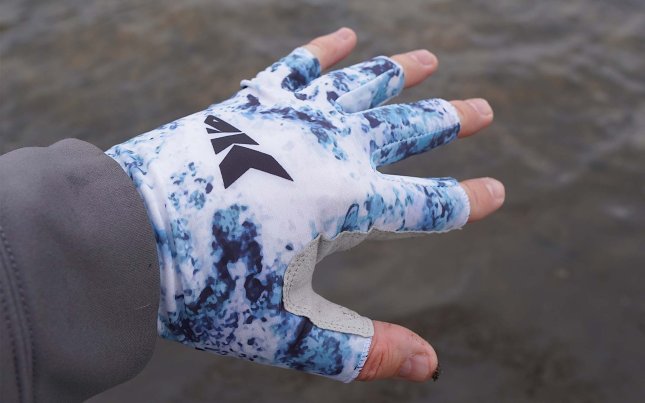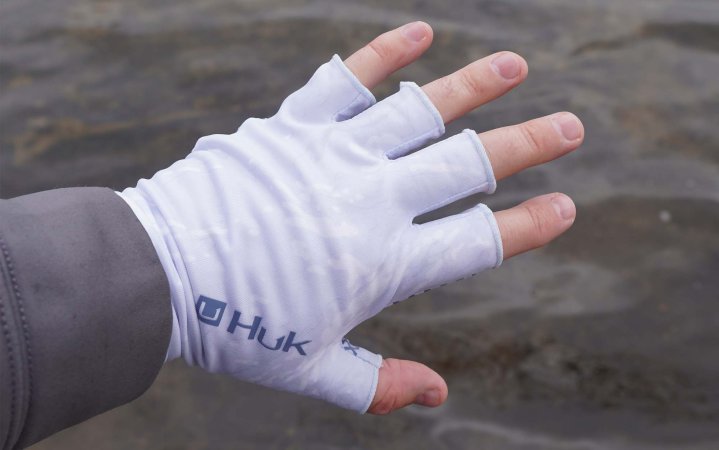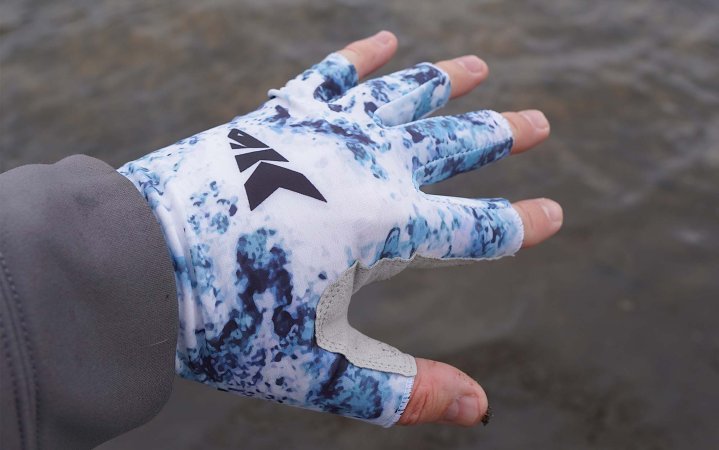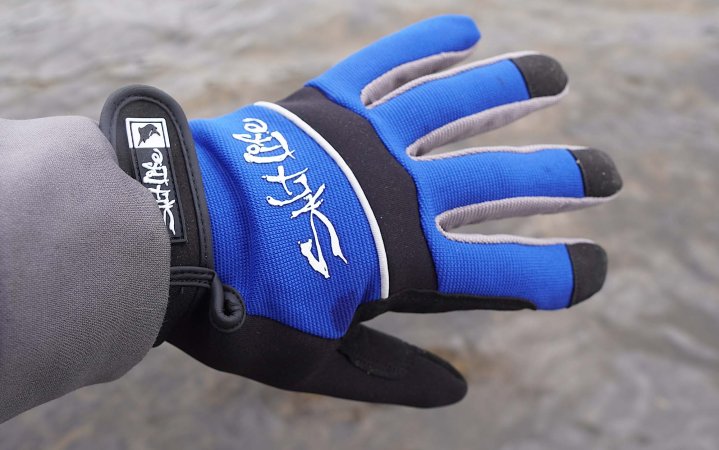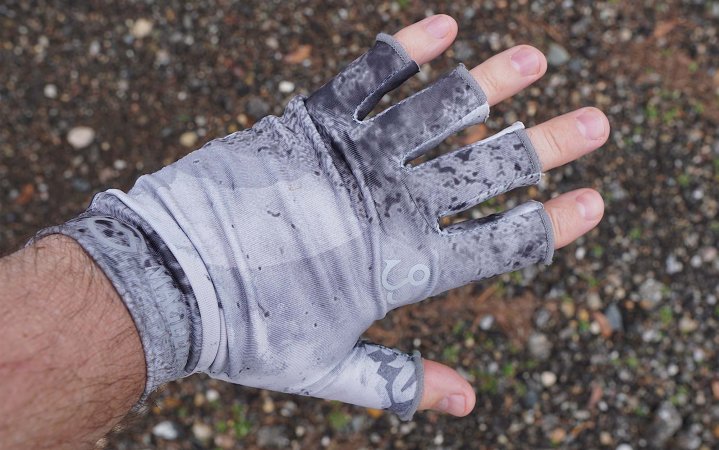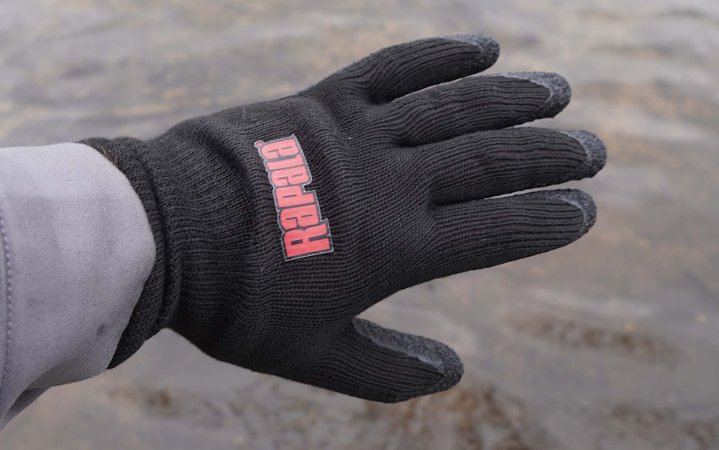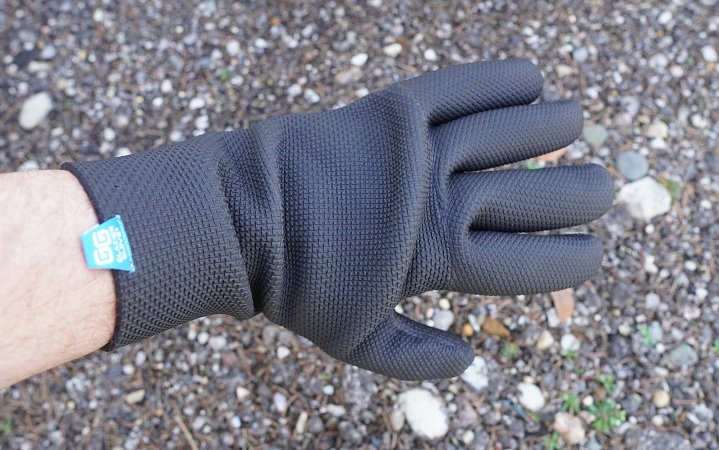We may earn revenue from the products available on this page and participate in affiliate programs. Learn More ›
An angler’s hands are subject to a lot of abuse. Fishing gloves can provide much-needed protection against cold water, fish slime, sharp spines, grasses, line cuts, hook barbs, the sun, and more. While some anglers fish without them, it can pay to protect your palms and digits, especially when dealing with the sun or hard fighters who won’t quit thrashing just because they’re in the boat.
With that in mind, I set out to find some of the best fishing gloves available today.
- Best Overall: Huk Mossy Oak Sun Gloves
- Best Sun Protection: Kast King La Sal Fishing Gloves
- Best for Saltwater: Salt Life Signature Fishing Gloves
- Best Dexterity: Magellan Outdoors Jacob Wheeler Pro Angler Gloves
- Best Budget: Rapala Fisherman’s Gloves
- Best for Winter: Glacier Glove Ice Bay
How I Tested the Best Fishing Gloves

Rz
I’ve been fishing most of my life, and I’ve worn gloves for years. While I had some ideas for my favorites, I subjected these gloves to simple tests. I tested the thickness of the material simply by pricking each glove with a sharp fishhook. Additionally, I carefully inspected each pair for loose threads or weak points that could lead to problems down the road.
I tied some knots with standard monofilament and braid to test dexterity while wearing each pair. Performance in water is a vital factor, so I completely submerged each pair to see how they felt when wet. I also noted how long each pair took to dry.
Best Fishing Gloves: Reviews & Recommendations
Best Overall: Huk Mossy Oak Sun Gloves
Key Features
- Material: Polyester
- Style: Fingerless
- Sun Protection: UPF 30+
Pros
- Very comfortable
- Great grips
- Longer wrist section
Cons
- Harder to remove
Huk’s new Mossy Oak sun gloves are nothing short of excellent. These gloves are incredibly lightweight and breathe well, especially when wet. The stitching of the gloves, especially around the ends of the fingerless portion, is clean. There are no loose threads here. Huk gave these gloves a fit that’s snug without being overly constrictive. But the real standout of these gloves is the texture on the palm. The grippy material covers the entire palm face and continues up all the fingers and down the length of the wrist. I always seem to have a perpetual case of butterfingers, and these gloves solve that while I’m fishing. Casting into tight windows of cover is much easier with the control these gloves provide.

Travis Smola
My only real complaint about these gloves is that the snug fit does make them slightly challenging to remove. I usually had to pull up on each half-finger section to loosen them first, especially while wet. However, the dexterity is excellent. I was quickly able to tie great knots while wearing these. There should be no reason to take them off until the end of a long day on the water. Add in a great price point, and these gloves were an easy pick for my favorite. I’m anticipating using these a lot as warmer weather arrives.
Best Sun Protection: Kast King La Sal Fishing Gloves
Specs
- Material: Polyester and spandex
- Style: Fingerless
- Sun Protection: UPF 50+
Pros
- Excellent sun protection
- Clean stitching and construction
- Great price point
Cons
- Grips don’t cover the whole palm
The La Sal fishing gloves look great and provide excellent sun protection for a bargain price point. I found them to be very comfortable and light. Tying knots with braid and monofilament lines was easy while wearing them. These gloves also dried out quickly after I thoroughly soaked them. The fabric is a little thicker than the other fingerless gloves I tested. This means there’s a little extra protection when handling rougher fish.
I do not like how these grips are only spread around the palm’s outside. The center portion of the palm doesn’t have any extra material, which slightly affects the grip. However, the material on the microfiber grips is rather rugged. It will repel the point of a sharp fishhook and spines to a degree. These gloves pair nicely with a long-sleeved fishing shirt to protect the arms and hands from the sun.
Best for Saltwater: Salt Life Signature Fishing Gloves
Specs
- Material: Polyester blend
- Style: Full gloves
- Sun Protection: N/A
Pros
- Extremely rugged
- Reinforced sections
- Great fit
Cons
- Reduced dexterity
A rugged glove is a must when tangling with hard-fighting fish like tuna, jack crevalle, or billfish. Salt Life’s signature gloves fit the bill perfectly. These gloves have some significant reinforcements across the palm and up the insides of the fingers. I pricked at this material with fishhooks and felt nothing. There won’t be too many problems with stray hooks or fish spines here. I completely soaked these gloves and didn’t lose any grip either. It’s easy to rein in a thrashing fish with these. These gloves will also ease the stress on the hands during longer fights.

Travis Smola
As expected, with thicker materials, these gloves lack dexterity. I was able to tie a knot while wearing them, but I don’t recommend them for rigging. Fortunately, these gloves are very easy to remove. I appreciate Salt Life adding a neoprene and Velcro cuff. It keeps the glove secure during more strenuous tasks. While these are primarily saltwater gloves, I could see these being used for some freshwater tasks too. These gloves would work great with gar, catfish, and other rough fish.
Best Dexterity: Magellan Outdoors Jacob Wheeler Pro Angler Gloves
Specs
- Material: Polyester and spandex
- Style: Fingerless
- Sun Protection: SPF 50+
Pros
- Very comfortable
- Great grips
- Fast drying
Cons
- Wrist covering feels short
Magellan is an Academy Sports brand that continues to impress me with its quality and value. Pro angler Jacob Wheeler designed these gloves to be light and airy. I love how cool my hands stay on hot days in the sun with these gloves. Most anglers are likely going to use these for freshwater. However, I wore these during a day of inshore fishing off the Texas coast. I caught about a half-dozen species including redfish, sea trout, and black drum. These gloves handed them all. The silicone grips on the palm are nice and tacky. I’ve never had a rod slip in my hands while wearing these, even when wet.
I found these gloves had the best dexterity of the bunch I tested. That’s primarily thanks to the low profile of the grips, which are a series of bumps. It’s effortless to grip thinner lines using these. The wrist area of these gloves is about an inch shorter than some other gloves. I also noticed the stitching isn’t the cleanest of the bunch. However, these gloves are incredibly comfortable and dry quickly when wet. They have been extremely durable and reliable for me the last year I’ve owned them.
Best Budget: Rapala Fisherman’s Gloves
Specs
- Material: Cotton and polyester
- Type: Full gloves
- Sun Protection: N/A
Pros
- Cheap
- Good grips
- Dries quickly
Cons
- Non-existent dexterity
Rapala’s fishing gloves are nothing flashy. They feature a simple cotton and polyester construction. The standout feature is the latex coating that covers the entire palm and most of the fingers. I found it to be thicker than it looks. Smaller fish hooks took some effort to penetrate this material. It’ll easily handle lipping the rough mouths of largemouth bass. These gloves will work great on fish with sharp gills like northern pike. I also like them for fish with sharp spines like bullheads. Although I’d use a little caution with teeth. The material isn’t quite thick enough for that.

Travis Smola
I wasn’t surprised that these gloves have almost no dexterity. I tried, but no one will be tying fishing line knots with these. These are going to be exclusively for fighting and landing fish. I would only put these on after a fish takes the bait. They aren’t comfortable enough for sustained casting. However, these gloves are dirt cheap. I picked mine up for less than $10. At that price point, there is no reason not to have an extra pair for every boat or tackle bag.
Best for Winter: Glacier Glove Ice Bay
Specs
- Material: Fleece and neoprene
- Type: Full glove
- Sun Protection: No
Pros
- Waterproof
- Very comfortable
- Warm
Cons
- Expensive
Fishing in winter demands a warmer glove, and the Glacier Glove Ice Bay is a good option that doesn’t compromise on dexterity. Thanks to their waterproof construction, these gloves are ideal for ice fishing. I was impressed that my hands never got wet while testing them. Water mostly rolls off the outer neoprene shell. This material also has a great texture to it. I had no problems gripping a rod and reel with these gloves. I couldn’t tie knots with them, but the dexterity was much better than I anticipated.

Travis Smola
These gloves aren’t much to look at, but there is something to be said for simplicity. Due to the neoprene construction, they are a little bit more expensive. I think it’s worth the price for anglers who regularly fish in cold weather. These gloves allow anglers to reach into the cold water without losing feeling.
How to Choose the Best Fishing Gloves

Travis Smola
Glove choice often comes down to personal preference. I prefer having a lot of dexterity in the finger portions of the glove. Thus, I tend to gravitate towards a fingerless style for most applications. Most freshwater anglers can get away with a very light option here. I usually only increase the thickness for colder weather or bigger fish such as catfish, tuna, or billfish.
Materials
For sun protection, a simple polyester and spandex blend works best. This is the same material used in most long-sleeved fishing shirts. These materials dry quickly and stay comfortable even when totally soaked. This style of glove also usually features a rating for sun protection. I burn quickly, so I typically look for UPF 50+, the maximum protection rating.
Neoprene is an excellent material for waterproof or warm winter gloves. It is also a suitable insulating material that pairs nicely with a fleece liner. It is ideal for winter fishing, especially ice fishing. While neoprene is an excellent material, it is more expensive than polyester.
Most fishing gloves have silicone or microfiber in the palm and grips. Silicone tends to add some tact, making it easier to grip a rod. Microfiber is usually layered in panels that add a little extra protection from errant hooks and spines.
Sizing
One of the more frustrating aspects of gloves is the inconsistent sizing techniques. There are charts out there, but I advise taking their measurements with a grain of salt because I’ve found them inaccurate more times than not. Most size charts put my glove size at large. However, large gloves are almost always too small for my hands, which is why I always size up to XL. I haven’t had any problems since I started doing that. I wish gloves could be true to size, but until it becomes a standard, I recommend going one size up.
Read Next: Best Fishing Pliers
FAQs
It might be better to consider the type of protection needed for the hands. For instance, fingerless sun gloves are great for dexterity in warmer weather. However, that style usually isn’t insulated, which means they won’t offer much warmth while ice fishing. Likewise, fish with rigid fins and bodies, such as tuna, will tear up a light pair of gloves quickly. Consider how the gloves will be utilized most to find the best pair for your angling style.
Many anglers have a valid concern about the protective coating of slime on fish they plan to release. Unfortunately, both gloves and bare hands can remove this coating. However, gloves can make handling species with excessive slime, like pike, muskie, and tuna, more manageable. Gloves can also reduce the chances of dropping the fish in the boat. Reducing handling time will also help preserve the fish’s slime coat.
If you intend to release the fish, wet your hands first, if possible. This simple step helps reduce the damage to the fish’s slime coating. Being mindful of this coating helps improve the fish’s odds of survival.
Final Thoughts on the Best Fishing Gloves
It was a close contest for me between the Huk and Magellan gloves for best overall. In the end, the grips of the Huk gloves won me over even though I liked Magellan’s sun protection better. Huk’s gloves also have the cleanest construction of the bunch. Although I think all these gloves have a place in an angler’s tool kit. It’s hard to go wrong with any of them depending on the style of fishing one does the most.
- Best Overall: Huk Mossy Oak Sun Gloves
- Best Sun Protection: Kast King La Sal Fishing Gloves
- Best for Saltwater: Salt Life Signature Fishing Gloves
- Best Dexterity: Magellan Outdoors Jacob Wheeler Pro Angler Gloves
- Best Budget: Rapala Fisherman’s Gloves
- Best for Winter: Glacier Glove Ice Bay

